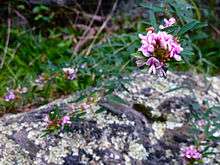Lespedeza virginica
Lespedeza virginica, known as slender bush clover or slender lespedeza, is a species of flowering plant native to much of the United States, as well as Ontario, Canada.[1] It is a member of the bean family, Fabaceae, and is listed as threatened in Wisconsin and New Hampshire.[2]
| Lespedeza virginica | |
|---|---|
 | |
| In Virginia, United States | |
| Scientific classification | |
| Kingdom: | Plantae |
| Clade: | Tracheophytes |
| Clade: | Angiosperms |
| Clade: | Eudicots |
| Clade: | Rosids |
| Order: | Fabales |
| Family: | Fabaceae |
| Genus: | Lespedeza |
| Species: | L. virginica |
| Binomial name | |
| Lespedeza virginica | |
Description
Lespedeza virginica is an herbaceous, perennial legume.[2] It can grow to be up to 2.5 feet tall. Slender bush clover has trifoliate compound leaves and slender primary petioles, with the stem covered in small white hairs. Its alternate leaves are dark green, though sometimes appear pale. The flowers are pink in color and have a broad upper petal with two side petals.[3] Flowers produced are either cleistogamous or chasmogamous.[4] Slender bush clover flowers from July to September and sets seed from September to October.[4] L. virginica grows well in environments with full to partial sun and can grow successfully in rocky or sandy soils. It produces a taproot to assist in establishment.
Distribution
Lespedeza virginica is found from Maine south to Florida, west to Texas and north to Michigan as well as in Eastern Canada.[1] L. virginica prefers drier habitats, but can be found in prairies, rocky and sandy forests, savannas and environments with high drainage such as roadsides.[3]
Herbivory
Lespedeza virginica is eaten by a wide variety of wildlife. It is a large part of the bobwhite quail's diet as well as deer and other ground birds. The seeds are eaten as well as the leaves. Nectar and pollen are eaten by various long-tongued insects such as butterflies and bees.[3]
Conservation
Lespedeza virginica is listed as threatened in Wisconsin and New Hampshire.[2]
References
- Lespedeza virginica. Lady Bird Johnson Wildflower Center. N.p., n.d. Web. 16 Dec. 2014.http://www.wildflower.org/plants/result.php?id_plant=LEVI7
- "Plants Profile for Lespedeza virginica (slender lespedeza)." 16 Dec. 2014.http://plants.usda.gov/core/profile?symbol=levi7
- "Slender Bush Clover (Lespedeza virginica)." 16 Dec. 2014.http://www.illinoiswildflowers.info/savanna/plants/sl_bushclover.htm
- Schutzenhofer, Michele R. "The Effect of Herbivory on the Mating System of Congeneric Native and ExoticSpecies." International Journal of Plant Sciences 168.7 (2007): 1021-026. Web.